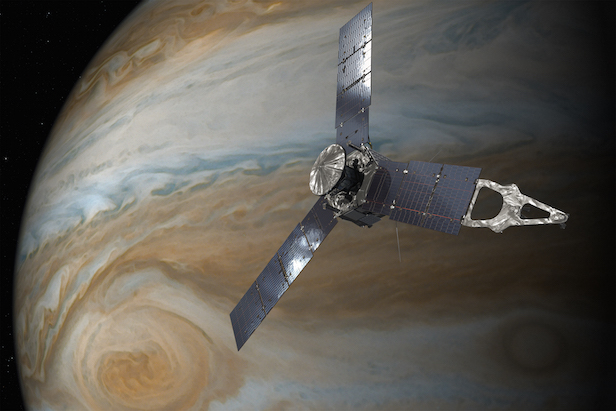Jupiter’s ‘light show’ found to pulsate at its poles
By observing the X-ray emissions from the Jovian planet, scientists speculate that the planet’s magnetic field could be causing unusual aurora

Jupiter’s south pole aurora seems to pulsate frequently and consistently, whereas the northern aurora is more erratic. Image credit: NASA/CXC/UCL/W.Dunn et al/STScl
NASA’s Chandra X-ray Observatory and ESA’s XMM-Newton Observatory have revealed that Jupiter’s northern and southern aurora pulsate independently to each other. By studying the high-energy X-ray emissions from Jupiter’s aurorae, the south pole consistently pulsate every 11 minutes, whereas the north pole emission is much more erratic.
On Earth, we are more familiar with our aurora in both poles mirroring each other’s activity. As for the other gas giant Saturn, it doesn’t produce any detectable X-ray aurora, proving these findings to be very perplexing about the true nature of Jupiter.
“We didn’t expect to see Jupiter’s X-ray hot spots pulsing independently as we thought their activity would be coordinated through the planet’s magnetic field,” explains William Dunn of UCL Mullard Space Science Laboratory, UK and the Harvard-Smithsonian Centre for Astrophysics, USA. “We need to study this further to develop ideas for how Jupiter produces its X-ray aurora and NASA’s Juno mission is really important for this.”
Since Juno’s arrival at Jupiter in 2016, the early results of the mission have challenged what we thought we knew about Jupiter. Unfortunately, the Juno spacecraft doesn’t have an X-ray analysis instrument aboard to provide more detailed observations. So by combining the Chandra and XMM-Newton data with Juno’s data, astronomers hope to gain to clearer understanding of how the X-ray aurorae are produced.
“If we can start to connect the X-ray signatures with the physical processes that produce them, then we can use those signatures to understand other bodies across the universe such as brown dwarfs, exoplanets or maybe even neutron stars,” says William Dunn. “It is a very powerful and important step towards understanding X-rays throughout the universe and one that we only have while Juno is conducting measurements simultaneously with Chandra and XMM-Newton.”

Although the Juno spacecraft doesn’t have X-rayinstruments aboard, it’s close encounters with the Jovian giant can provide vital information to continue this discovery. Image credit: NASA/JPL-Caltech
One of theories about Jupiter, which Juno could help to prove or disprove, is that Jupiter’s aurorae form separately when the planet’s magnetic fields interact with solar winds. Astronomers also suspect that the magnetic field lines of Jupiter vibrate, causing waves that transport highly energetic particles towards the poles. However, these waves change in speed and direction until they collide with the gas giant’s atmosphere, therefore generating the observable X-ray pulses.
By using both the XMM-Newton and Chandra space observatories in May to June 2016 and March 2007, the astronomers were able to produce maps of Jupiter’s X-ray emission and identify an X-ray hot spot at each pole. Each hot spot was larger than the surface of Earth, and after studying their patterns, they showed to have very different characteristics.
“What I find particularly captivating in these observations, especially at the time when Juno is making measurements in situ, is the fact that we are able to see both of Jupiter’s poles at once, a rare opportunity that last occurred ten years ago,” concludes Professor Graziella Branduardi-Raymont of UCL Space & Climate Physics. “Comparing the behaviours at the two poles allows us to learn much more of the complex magnetic interactions going on in the planet’s environment.”
Keep up to date with the latest reviews in All About Space – available every month for just £4.99. Alternatively you can subscribe here for a fraction of the price!




